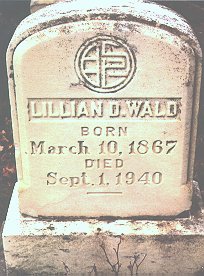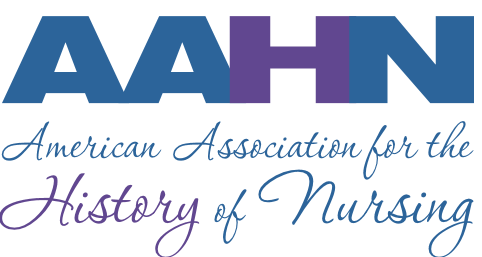
she had designed for the Henry Street Settlement to signify "we are all one family".
She is buried in Mount Hope Cemetery, Rochester, NY.
- Born March 10, 1867 in Cincinnati OH, 3rd of 4 children; father dealer in optics
- Completed training at New York Hospital in 1891
- 1891-92 Worked at New York Juvenile Asylum where her concern for the homeless and abused of institutionalization gave birth to her advocacy role
- Entered Women's Medical College; during first year was teaching class on home care/hygiene to immigrant women in a school on Henry Street - she described this as her baptism by fire. Quit medical school
- 1893 she and a classmate, Mary Brewster, moved into a lower east side neighborhood and provided nursing care among the community. Neighbors came to the apartment for help on health, education, jobs, housing. This was the genesis of public health nursing.
- Philantropist Jacob Schiff and Mrs Solomon Loeb funded Wald and Brewtser, Mr. Schiff purchased a house on Henry Street which became the Henry Street Settlement
- Settlement offered playground, reading classes, promoted special education for "backward" children, had study rooms and helped children with homework
- 1902 convinced Board of Education to hire school nurses
- 1903 Helped develop Women's Trade Union League
- 1904 With Florence Kelley founded the National Child Labor Committee
- 1905 helped to organize the National Association for the Advancement of Colored People (NAACP).
- Activist against boarding out babies, supporter of organized labor , savings plans,
- Persuaded President T. Roosevelt to start Federal Children's Bureau
- She started Town and Country Nursing Service of Red Cross
- Convinced Metropolitan Life Insurance to hire nurses
- 1912 Founder and first president of National Organization for Public Health Nursing
- Organized march against WWI
- Served on Red Cross Committees during Influenza epidemic and WWI
- Left Henry Street in 1933; still served a President of Board until 1937
Some writings by Miss Wald:
- Wald L.D. (1902). The nurses' settlement in New York. American Journal of Nursing, 1902; 2: 568.
- Wald, L.D. (1912 ) Address by the President of the National Organization for Public Health Nursing. American Journal of Nursing 13, 924-6.
- Wald, L.D. (1915). The house on Henry Street. New York: Henry Holt and Company.
- Wald, L.D. (1934). Windows on Henry Street Boston: Little and Brown.
Sources:
Backer, B. (1993). Lillian Wald: Connecting caring with activism. Nursing & Health Care 14(3), 122-9.
Buhler-Wilkerson,K. (1993). Bringing care to the people: Lillian Wald's legacy to public health nursing American Journal of Public Health 83(12): 1778-86.
Christy, T.E. (1970). Portrait of a leader: Lillian D. Wald. Nursing Outlook, 84-88
Cook, B.W. (1977) Female support networks and political activism: Lillian Wald, Crystal Eastman, Emma Goldman. Chrysalis 3, 43-61.
Daniels, D.G. (1989). Always a sister. The feminism of Lillian D. Wald. New York: Feminist Press.
Fitzpatrick, M.L. (1990). Lillian D. Wald: prototype of an involved nurse. Imprint 37(2): 92-5.
Frachel, R.R. (1988). A new profession: the evolution of public health nursing Public Health Nursing 5(2): 86-90
Silverstein, N.G. (1985) Lillian Wald at Henry Street, 1893-1895 Advances in Nursing Science 7(2): 1-12.
